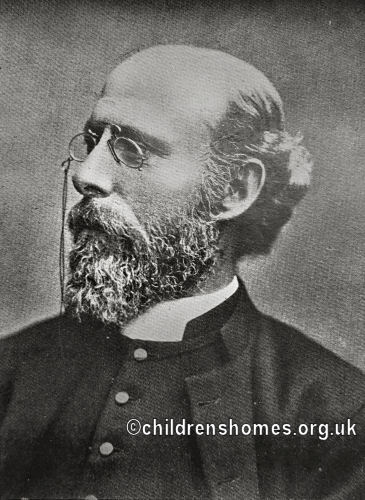The Waifs and Strays Story
Edward Rudolf
The 'Waifs and Strays Society' (now the Church of England Children's Society), one of Britain's largest child care agencies from the late nineteenth century up to the present day, owes its existence to Edward de Montjoie Rudolf. Rudolf was born on April 11th, 1852, at 63 Pleasant Place, West Square, Lambeth. Edward was the second son of Major William Edward Rudolf, a sixty-seven-year-old former officer in the Light Dragoons and in the Dutch Army, and his wife Susan, who was almost fifty years his junior. The family were relatively poor, although an allowance from the Major's brother, William, helped pay for the education of Edward's elder brother, Richard. Neither Edward nor his younger brother, Robert, attended school but were taught by their father, a somewhat stern and authoritarian figure, with rigid religious beliefs. The Major, who was something of a linguist, earned a little money earned a little money by translation work. As his eyesight grew increasingly poor, he was helped in the work by young Edward. Edward's upbringing was thus characterised by strictness, financial insecurity, religious observance, and a sense of duty.
At around the age of 14, Edward started work as an office-boy in Blackfriars. He also studied in the evening to try and remedy his lack of formal education. His father then secured him a post as a junior clerk at the Dutch Consulate. Life at home was increasingly disrupted by the eldest son, now known as Dick, who was constantly in trouble, including a spell in a House of Correction after stealing some money. Dick's eventual decision to emigrate to America in 1870 was followed by the death of their father in January 1871 and their mother's admission to the Bethlem Hospital a fortnight later.
Things began to look up when March 1871, Edward passed the Civil Service examination and two months later took up a post at the Office of Works, Whitehall, at a salary of £100 a year. In July, his mother left hospital and she, Edward and Robert moved to an apartment at 341 Kennington Road.
Sometime in around 1867 or 1868, Edward Rudolf was walking home from work one evening when he came across a small boy sitting alone on a doorstep. The boy was homeless and had nowhere to go. Unsure what to do, Rudolf eventually found the boy shelter for the night at the local police station. The small incident planted a seed that was to set the direction of Rudolf's life. In September 1869, he became involved in the running of a Popular Educator Class held at the rear of Walworth Road Chapel. Six months later he decided that his life's ambitions were to enter the Ministry, and also to found an orphanage for outcast and destitute children.

Edward Rudolf, 1897. © Peter Higginbotham
Over the next decade, these ambitions slowly came to fruition. In 1870, Rudolf started studying Greek and Divinity at the City of London College. The following year, he opened a successful night school at St Philip's church in Kennington then, after the family moved to new lodgings at Portland Place, Kennington, became Superintendent of the Sunday School in the parish of St Anne's, a post he held for ten years. He became increasingly involved in the work of the parish, while at the same time was steadily advancing his career up the Office of Works. He also found time, in 1874, to join the Guild of St Alban, a brotherhood of devout laymen who assisted the clergy by undertaking social work in deprived urban areas. One of the brothers' duties was a devotion 'to the education of the young in the doctrine and discipline of the Church, to reclaiming the lost and raising the fallen'. It is thought that Guild may itself have either managed or financially supported a boys' home.
Another important event during this period was his encounter with the Bulmers, a fairly well-to-do family in the parish whose two daughters, Minnie and Emma, were considered local beauties. Emma, although having studied art in South Kensington, was employed as a painter at Doulton's pottery works. She was later to become a novelist, an inventor, a suffragette, and a member of the Fabian Society. At Rudolf's suggestion, Emma became a teacher at the St Anne's Sunday School. Before too long, a romance developed and they became engaged in 1879.
Except where indicated, this page () © Peter Higginbotham. Contents may not be reproduced without permission.


